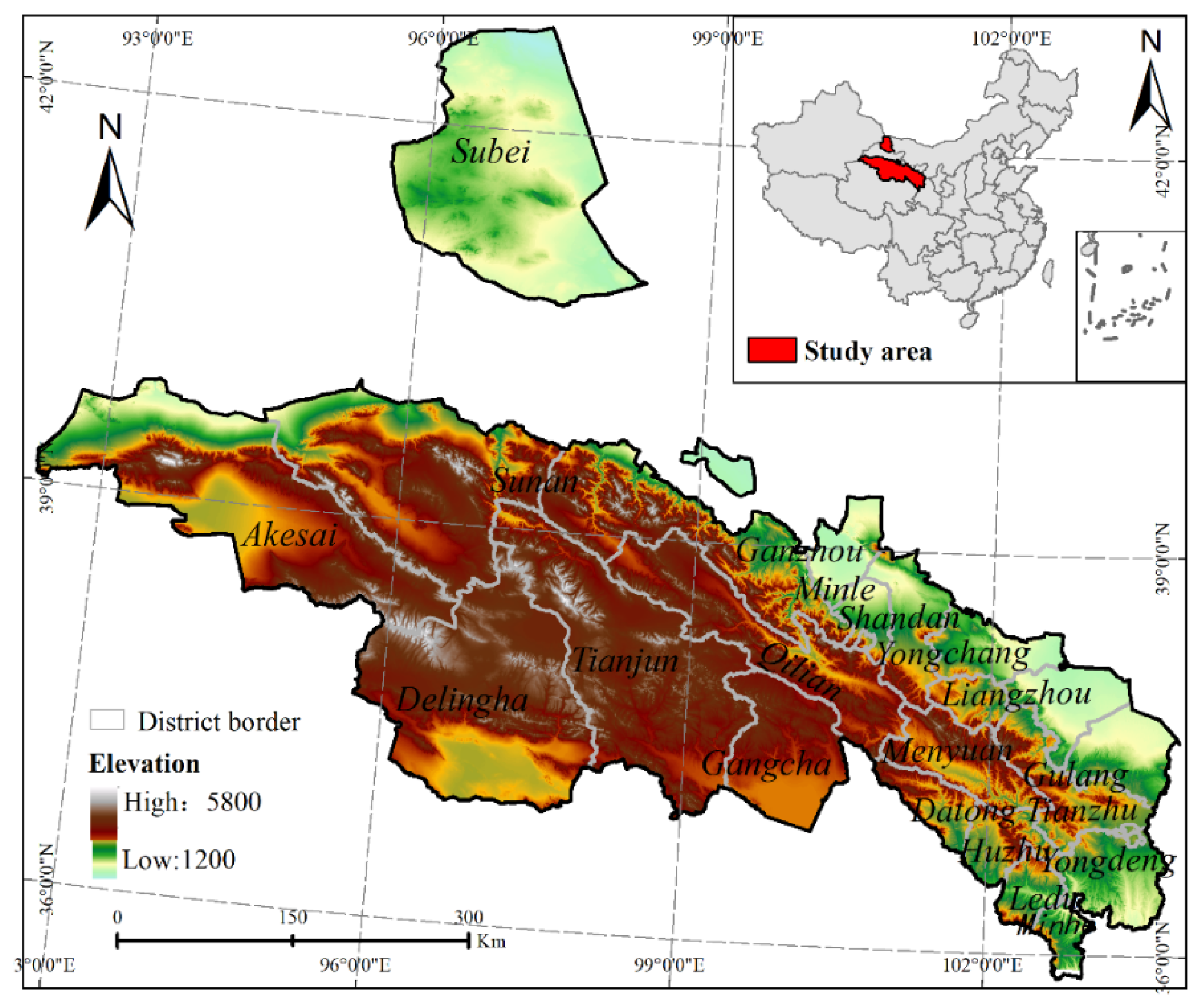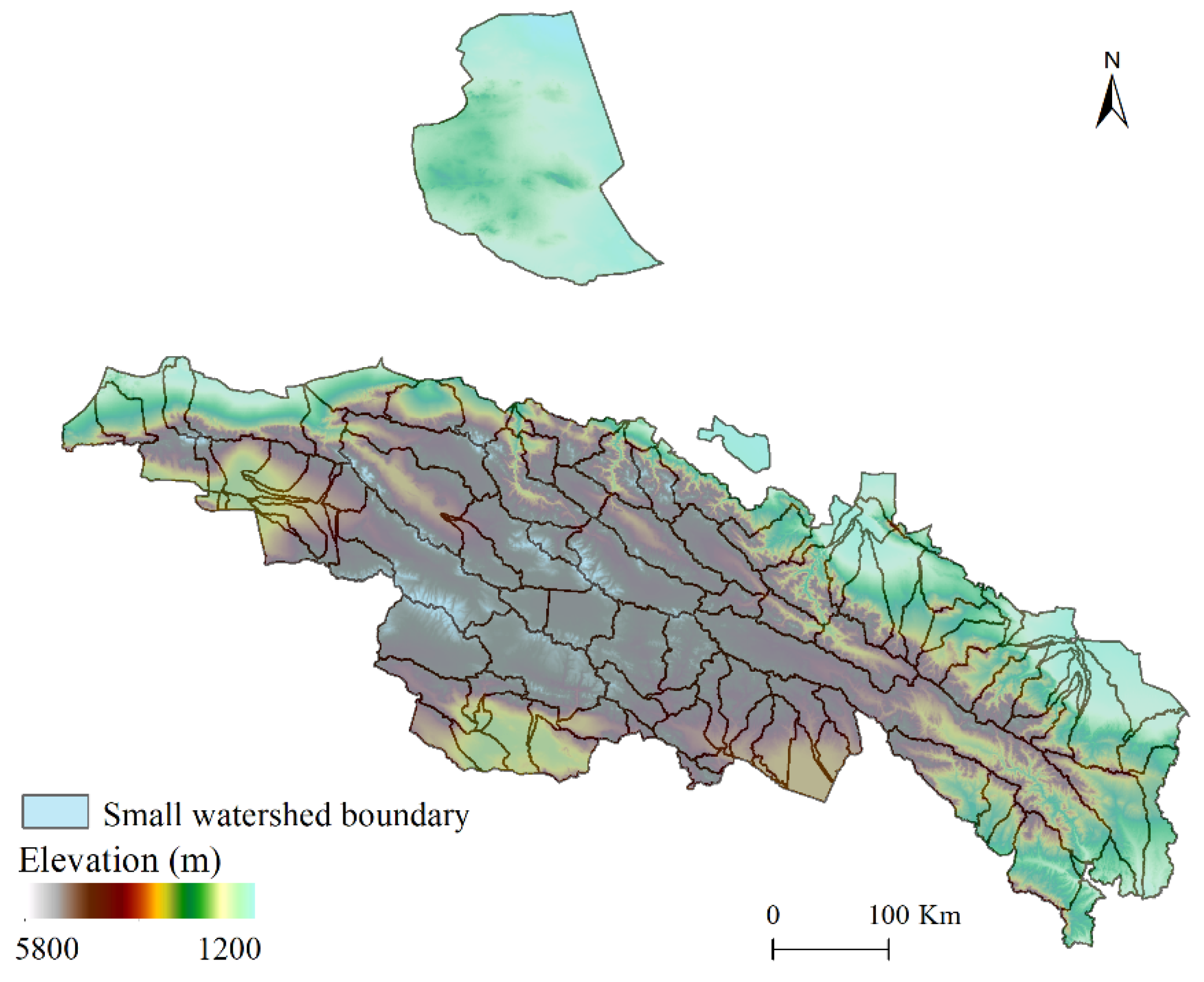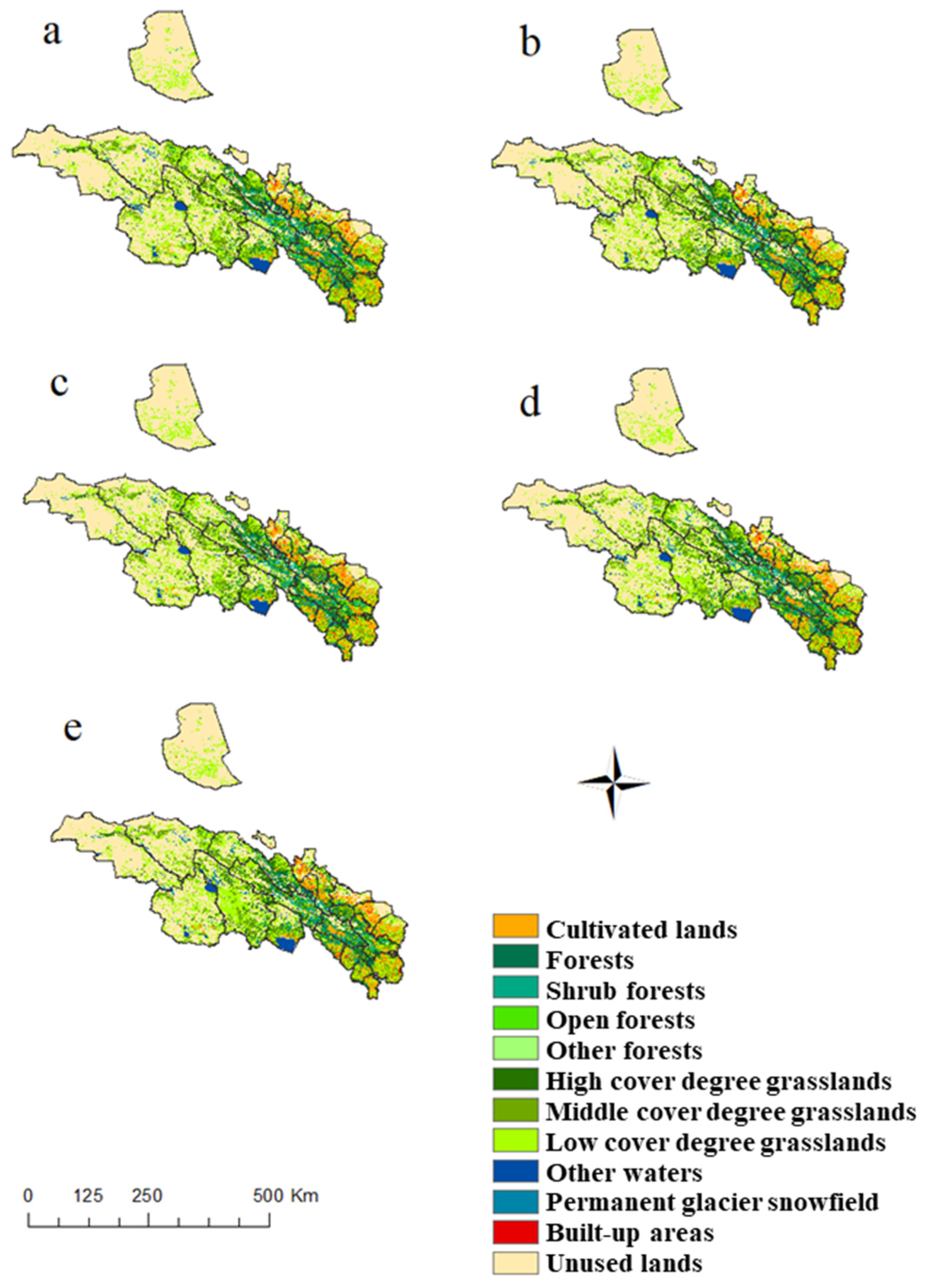Zoning of Ecological Restoration in the Qilian Mountain Area, China
Abstract
:1. Introduction
- -
- In Section 2, we introduce the study area and data sources.
- -
- In Section 3, we introduce the methods used for ecological restoration zoning.
- -
- In Section 4, we document the key areas of ecological restoration and their ecological problems.
- -
- The limitations and future research prospects are discussed in Section 5.
- -
- The conclusions are then presented in Section 6.
2. Study Area and Data Sources
2.1. Study Area
2.2. Data Sources
3. Research Methods
3.1. Index System Construction
3.2. Ecological Restoration Index (ERI) of the Qilian Mountains
3.3. Division of Basic Evaluation Units Based on River Basin Division
4. Results
4.1. Land Use Change in the Qilian Mountains from 1990–2015
4.2. Key Areas of Ecological Restoration in the Qilian Mountains
4.3. Ecological Restoration Zoning of the Qilian Mountains
4.4. Ecological Problems of Different Ecological Restoration Zones
5. Discussion
6. Conclusions
Author Contributions
Funding
Institutional Review Board Statement
Informed Consent Statement
Data Availability Statement
Conflicts of Interest
Appendix A
The Specific Calculation Process of Indicators
- (1)
- Soil Conservation
- (2)
- Mine Distribution Acquisition
- (3)
- Precipitation and Extreme Precipitation
- (4)
- Interannual Change Rate of Forests and Grassland Vegetation
References
- Milan, R. The ecological and environmental education. Ekol. Bratisl. 1995, 14, 145–151. [Google Scholar]
- Fischer, S.; Thatje, S. Temperature effects on life-history traits cause challenges to the management of brachyuran crab fisheries in the Humboldt Current: A review. Fish. Res. 2016, 183, 461–468. [Google Scholar] [CrossRef]
- Omernik, J.M.; Griffith, G.E. Ecoregions of the Conterminous United States: Evolution of a Hierarchical Spatial Framework. Environ. Manag. 2014, 54, 1249–1266. [Google Scholar] [CrossRef]
- Olson, D.M.; Dinerstein, E. The Global 200: A Representation Approach to Conserving the Earth’s Most Biologically Valuable Ecoregions. Conserv. Biol. 1998, 12, 502–515. [Google Scholar] [CrossRef] [Green Version]
- Omernik, J.M. Ecoregions: A framework for managing ecosystems. Georg. Wright Forum 1995, 12, 35–50. [Google Scholar]
- Box, W.E. Global classification of natural terrestrial ecosystems. Vegetatio 1976, 32, 75–81. [Google Scholar] [CrossRef]
- Bailey, R.G.; Zoltai, S.C.; Wiken, E.B. Ecological regionalization in Canada and the United States. Geoforum 1985, 16, 265–275. [Google Scholar] [CrossRef]
- Zogaris, S.; Economou, A.N.; Dimopoulos, P. Ecoregions in the Southern Balkans: Should Their Boundaries Be Revised? Environ. Manag. 2009, 43, 682–697. [Google Scholar] [CrossRef]
- Zhou, L.; Sun, D.; Xu, J. Zoning assessment of water environmental supporting capacity for socioeconomic development in the Huaihe River Basin, China. J. Geogr. Sci. 2015, 25, 1199–1217. [Google Scholar] [CrossRef]
- Yang, S.Y.; Tang, T.; Cai, Q.H.; Xiao, W.; Wang, X.Z.; Li, F.Q.; Tang, J. Aquatic eco-regionalization of Erhai Lake Basin, Yunnan Province of Southwest China. Chin. J. Ecol. 2012, 31, 1798–1806. [Google Scholar] [CrossRef]
- Liu, X.; Liu, L.; Peng, Y. Ecological zoning for regional sustainable development using an integrated modeling approach in the Bohai Rim, China. Ecol. Modell. 2017, 353, 158–166. [Google Scholar] [CrossRef]
- Deboudt, P.; Dauvin, J.-C.; Lozachmeur, O. Recent developments in coastal zone management in France: The transition towards integrated coastal zone management (1973–2007). Ocean Coast. Manag. 2008, 51, 212–228. [Google Scholar] [CrossRef]
- Pikitch, E.K.; Santora, C.; Babcock, E.A.; Bakun, A.; Bonfil, R.; Conover, D.O.; Dayton, P.; Doukakis, P.; Fluharty, D.; Heneman, B.; et al. Sainsbury. Ecosystem-Based Fishery Management. Science 2004, 305, 346–347. [Google Scholar] [CrossRef]
- Li, F.; Xu, M.; Liu, Q.; Wang, Z.; Xu, W. Ecological restoration zoning for a marine protected area: A case study of Haizhouwan National Marine Park, China. Ocean Coast. Manag. 2014, 98, 158–166. [Google Scholar] [CrossRef]
- Yang, X.; Zhang, F.; Luo, C.; Zhang, A. Farmland Ecological Compensation Zoning and Horizontal Fiscal Payment Mechanism in Wuhan Agglomeration, China, From the Perspective of Ecological Footprint. Sustainability 2019, 11, 2326. [Google Scholar] [CrossRef] [Green Version]
- Wang, G.; Yang, D.; Xia, F.; Zhong, R.; Xiong, C. Three Types of Spatial Function Zoning in Key Ecological Function Areas Based on Ecological and Economic Coordinated Development: A Case Study of Tacheng Basin, China. Chin. Geogr. Sci. 2019, 29, 689–699. [Google Scholar] [CrossRef] [Green Version]
- Wang, Y.; Li, H.; Ren, J. Delimitation and Zoning of Natural Ecological Spatial Boundary Based on GIS. Asian J. Agric. Res. 2019, 11, 40–45. [Google Scholar] [CrossRef]
- Mamat, K.; Du, P.; Ding, J. Ecological function regionalization of cultural heritage sites in Turpan, China, based on GIS. Arab. J. Geosci. 2017, 10, 90. [Google Scholar] [CrossRef]
- Wang, L.; Wang, W.; Yang, X. Eco-Environmental Zoning: A GIS-Based Approach. In Proceedings of the 2008 2nd International Conference on Bioinformatics and Biomedical Engineering, Shanghai, China, 16–18 May 2008. [Google Scholar] [CrossRef]
- Shao, J.; Yang, L.; Peng, L.; Chi, T.; Wang, X. An Improved Artificial Bee Colony-Based Approach for Zoning Protected Ecological Areas. PLoS ONE 2015, 10, e0137880. [Google Scholar] [CrossRef]
- Read, A.D.; West, R.J. Qualitative risk assessment of multiple-use marine park effectiveness–A case study from NSW, Australia. Ocean Coast. Manag. 2010, 53, 636–644. [Google Scholar] [CrossRef]
- Guo, Y. Spatial Distribution and Simulation of Cropland Abandonment in Wushan County, Chongqing, China. Sustainability 2019, 11, 1367. [Google Scholar] [CrossRef] [Green Version]
- Liu, Y.; Song, W.; Deng, X. Understanding the spatiotemporal variation of urban land expansion in oasis cities by integrating remote sensing and multi-dimensional DPSIR-based indicators. Ecol. Indic. 2019, 96, 23–37. [Google Scholar] [CrossRef]
- Abutaleb, K.A.A.; Asmaa, M.; Hassan, E.; Ahmed, M. Climate Change Impacts, Vulnerabilities and Adaption Measures for Egypt’s Nile Delta. Earth Syst. Environ. 2018, 2, 183–192. [Google Scholar] [CrossRef]
- Yulin, S. 1:1 Million Land Resources Map of China; Science Press: Beijing, China; Shanghai, China, 1990. [Google Scholar]
- Alcantara, C.; Kuemmerle, T.; Prishchepov, A.V.; Radeloff, V.C. Mapping abandoned agriculture with multi-temporal MODIS satellite data. Remote Sens. Environ. 2012, 124, 334–347. [Google Scholar] [CrossRef]
- Qian, X.; Zhu, H. A 1-km grid dataset of industrial output value in China (2010). China Sci. Date 2018, 3, 1–13. [Google Scholar] [CrossRef]
- Xiaoming, W.; Junxing, Y.; Wei, S. Pollution status of agricultural land in China: Impact of land use and geographical position. Soil Water Res. 2018, 13, 234–242. [Google Scholar] [CrossRef] [Green Version]
- Bliss, S. United Nations International Year of Forests 2011. Geogr. Bull. 2011, 43, 33. [Google Scholar]
- Wang, P.; Zhang, L.; Li, Y.; Jiao, L.; Wang, H.; Yan, J.; Lü, Y.; Fu, B. Spatio-temporal characteristics of the trade-off and synergy relationships among multiple ecosystem services in the Upper Reaches of Hanjiang River Basin. Acta Geogr. Sin. 2017, 72, 2064–2078. [Google Scholar] [CrossRef]
- Gao, Y.; Liu, H.; Liu, G. The spatial distribution and accumulation characteristics of heavy metals in steppe soils around three mining areas in Xilinhot in Inner Mongolia, China. Environ. Sci. Pollut. Res. 2017, 24, 25416–25430. [Google Scholar] [CrossRef]
- Li, H.; Song, W. Characteristics of Climate Change in the Lancang-Mekong Sub-Region. Climate 2020, 8, 115. [Google Scholar] [CrossRef]
- Han, Z.; Song, W.; Deng, X.; Xu, X. Grassland ecosystem responses to climate change and human activities within the Three-River Headwaters region of China. Sci. Rep. 2018, 8, 9079. [Google Scholar] [CrossRef] [PubMed] [Green Version]
- Deng, X.; Huang, J.; Rozelle, S.; Uchida, E. Cultivated land conversion and potential agricultural productivity in China. Land Use Policy 2006, 23, 372–384. [Google Scholar] [CrossRef]
- Jian, S.; Deng, G. The Chinese Urban and Rural per Capita Income and Trend Analysis. Appl. Math. 2014, 5, 106–109. [Google Scholar] [CrossRef] [Green Version]
- Ding, L.; Zhao, W.; Huang, Y.; Cheng, S.; Liu, C. Research on the Coupling Coordination Relationship between Urbanization and the Air Environment: A Case Study of the Area of Wuhan. Atmosphere 2015, 6, 1539–1558. [Google Scholar] [CrossRef] [Green Version]
- Liao, C.; Yue, Y.; Wang, K.; Fensholt, R.; Tong, X.; Brandt, M. Ecological restoration enhances ecosystem health in the karst regions of southwest China. Ecol. Indic. 2018, 90, 416–425. [Google Scholar] [CrossRef]
- Li, H.; Song, W. Spatiotemporal Distribution and Influencing Factors of Ecosystem Vulnerability on Qinghai-Tibet Plateau. Int. J. Environ. Res. Public Health 2021, 18, 6508. [Google Scholar] [CrossRef] [PubMed]
- Su, X.; Zhou, Y.; Li, Q. Designing Ecological Security Patterns Based on the Framework of Ecological Quality and Ecological Sensitivity: A Case Study of Jianghan Plain, China. Int. J. Environ. Res. Public Health 2021, 18, 8383. [Google Scholar] [CrossRef]
- Kang, J.; Zhang, X.; Zhu, X.; Zhang, B. Ecological security pattern: A new idea for balancing regional development and ecological protection. A case study of the Jiaodong Peninsula, China. Glob. Ecol. Conserv. 2021, 26, e01472. [Google Scholar] [CrossRef]
- Jin, X.; Jin, Y.; Mao, X. Ecological risk assessment of cities on the Tibetan Plateau based on land use/land cover changes—Case study of Delingha City. Ecol. Indic. 2019, 101, 185–191. [Google Scholar] [CrossRef]
- Dieleman, H. Urban agriculture in Mexico City; balancing between ecological, economic, social and symbolic value. J. Clean. Prod. 2017, 163, S156–S163. [Google Scholar] [CrossRef]
- Jongman, R.H.G. Nature conservation planning in Europe: Developing ecological networks. Landsc. Urban Plan. 1995, 32, 169–183. [Google Scholar] [CrossRef]
- Fábos, J.G. Greenway planning in the United States: Its origins and recent case studies. Landsc. Urban Plan. 2004, 68, 321–342. [Google Scholar] [CrossRef]
- Peng, J.; Zhao, H.; Liu, Y. Urban ecological corridors construction: A review. Acta Ecol. Sin. 2017, 37, 23–30. [Google Scholar] [CrossRef]
- Xue, L.; Wang, J.; Zhang, L.; Wei, G.; Zhu, B. Spatiotemporal analysis of ecological vulnerability and management in the Tarim River Basin, China. Sci. Total Environ. 2018, 649, 876–888. [Google Scholar] [CrossRef] [PubMed]
- Zhang, Y.; Shen, J. Wetland Restoration Planning Approach Based on Interval Fuzzy Linear Programming under Uncertainty. Int. J. Environ. Res. Public Health 2021, 18, 9549. [Google Scholar] [CrossRef]
- Jiang, C.; Wang, F.; Zhang, H.; Dong, X. Quantifying changes in multiple ecosystem services during 2000–2012 on the Loess Plateau, China, as a result of climate variability and ecological restoration. Ecol. Eng. 2016, 97, 258–271. [Google Scholar] [CrossRef]
- Huber, S.; Prokop, G.; Arrouays, D.; Banko, G.; Bispo, A.; Jones, R.J.A.; Kibblewhite, M.G.; Lexer, W.; Moller, A.; Rickson, R.J.; et al. Environmental Assessment of Soil for Monitoring: Volume I Indicators & Criteria; Office for the Official Publications of the European Communities Press: Ispra, Italy, 2008. [Google Scholar]
- Wischmeier, W.H.; Smith, D.D. Predicting Rainfall Erosion Losses—A Guide to Conservation Planning; Agriculture Handbook No. 537; US Department of Agriculture Science and Education Administration: Washington, DC, USA, 1978; Volume 58. [Google Scholar]
- Silva, A.M.D. Rainfall erosivity map for Brazil. Catena 2004, 57, 259. [Google Scholar] [CrossRef]
- Renard, K.G.; Foster, G.R.; Weesies, G.A.; Mccool, D.K.; Yoder, D.C. Predicting Soil Erosion by Water: A Guide to Conservation Planning with the Revised Universal Soil Loss Equation (RUSLE); Agricultural Handbook; United States Department of Agriculture Press: New York, NY, USA, 1997. [Google Scholar]
- Williams, J.R.; Arnold, J.G. A system of erosion—Sediment yield models. Soil Technol. 1997, 11, 43–55. [Google Scholar] [CrossRef]
- Li, S.; Wang, Z.; Zhang, Y. Crop cover reconstruction and its effects on sediment retention in the Tibetan Plateau for 1900–2000. J. Geogr. Sci. 2017, 27, 786–800. [Google Scholar] [CrossRef]
- Ma, M.; Frank, V. Interannual variability of vegetation cover in the Chinese Heihe River Basin and its relation to meteorological parameters. Int. J. Remote Sens. 2006, 27, 3473–3486. [Google Scholar] [CrossRef]
- Piao, S.; Wang, X.; Ciais, P.; Zhu, B.; Wang, T.; Liu, J. Changes in satellite-derived vegetation growth trend in temperate and boreal Eurasia from 1982 to 2006. Glob. Chang. Biol. 2011, 17, 3228–3239. [Google Scholar] [CrossRef]
- Xia, H.; Li, A.; Feng, G.; Li, Y.; Qin, Y.; Lei, G.; Cui, Y. The Effects of Asymmetric Diurnal Warming on Vegetation Growth of the Tibetan Plateau over the Past Three Decades. Sustainability 2018, 10, 1103. [Google Scholar] [CrossRef] [Green Version]







| Type | Ecological Issues | Indicators | Meaning of the Index |
|---|---|---|---|
| Mountain | Soil erosion | Amount of soil conservation | Application of land use and management methods to prevent soil erosion by human or natural factors to maintain the total amount of natural soil functions |
| Mining | Mine distribution density | Reference to the number of mines within a certain geographical space range | |
| Water | Extreme precipitation | Rainstorm days | Number of days with daily precipitation exceeding 50 mm |
| Uneven precipitation distribution | Annual precipitation | The sum of the average monthly precipitation in the year represents the annual precipitation | |
| Forestry areas | Forest is degraded | Interannual change rate of forest vegetation | Changes of forest vegetation within one year |
| Poor forest score quality | |||
| Cultivated land | Low farm quality | Agricultural production potential | Agricultural production potential is the maximum possible output to be achieved annually on lands per unit of land |
| Grassland | Meadows are degraded | Interannual change rate of grassland vegetation | Changes of grassland vegetation within one year |
| People | Poverty situation | Rural per capita income | Average income of rural individuals within one year |
| Evaluation Indicators | Ecological Restoration Object | Indicator Weight |
|---|---|---|
| Amount of soil conservation | Mountains; rivers; and forests | 0.3 |
| Mine distribution density | Mountains | 0.1 |
| Extreme precipitation | Rivers | 0.1 |
| Annual precipitation | Rivers | 0.1 |
| Interannual change rate of forest vegetation | Forests | 0.1 |
| Interannual change rate of grassland vegetation | Grasslands | 0.1 |
| Cultivated land grade | Cultivated lands | 0.1 |
| Rural income per capita | People | 0.1 |
| First-Level Division | Secondary Division | Regional Area: Ten Thousand (km2) | Area Ratio (%) | Ecological Restoration Index |
|---|---|---|---|---|
| I—forests’ and grasslands’ water conservation areas | 1—headwaters of the Datong River Basin | 2.75 | 11.61 | 0.54 |
| 2—Danghe-Dahaerteng River Basin | 2.80 | 11.83 | 0.65 | |
| 5—northern confluence area of the Qinghai Lake | 3.28 | 13.84 | 0.62 | |
| 6—upper Shule River to middle Heihe River | 3.62 | 15.26 | 0.50 | |
| II—cultivated lands’ and grasslands ecological restoration areas | 4—Oasis Agricultural Area at the northern foothills of the Qilian Mountains | 3.43 | 14.45 | 0.68 |
| 7—Huangshui Basin Valley | 0.66 | 2.77 | 0.73 | |
| III—deserted grasslands’ ecological control area | 3—Aksay, corridor region of the western Hexi Basin | 6.11 | 25.78 | 0.56 |
| 8—northeastern Tsaidam Basin | 1.06 | 4.46 | 0.57 |
Publisher’s Note: MDPI stays neutral with regard to jurisdictional claims in published maps and institutional affiliations. |
© 2021 by the authors. Licensee MDPI, Basel, Switzerland. This article is an open access article distributed under the terms and conditions of the Creative Commons Attribution (CC BY) license (https://creativecommons.org/licenses/by/4.0/).
Share and Cite
Liu, L.; Song, W.; Zhang, Y.; Han, Z.; Li, H.; Yang, D.; Wang, Z.; Huang, Q. Zoning of Ecological Restoration in the Qilian Mountain Area, China. Int. J. Environ. Res. Public Health 2021, 18, 12417. https://doi.org/10.3390/ijerph182312417
Liu L, Song W, Zhang Y, Han Z, Li H, Yang D, Wang Z, Huang Q. Zoning of Ecological Restoration in the Qilian Mountain Area, China. International Journal of Environmental Research and Public Health. 2021; 18(23):12417. https://doi.org/10.3390/ijerph182312417
Chicago/Turabian StyleLiu, Lin, Wei Song, Yanjie Zhang, Ze Han, Han Li, Dazhi Yang, Zhanyun Wang, and Qiang Huang. 2021. "Zoning of Ecological Restoration in the Qilian Mountain Area, China" International Journal of Environmental Research and Public Health 18, no. 23: 12417. https://doi.org/10.3390/ijerph182312417
APA StyleLiu, L., Song, W., Zhang, Y., Han, Z., Li, H., Yang, D., Wang, Z., & Huang, Q. (2021). Zoning of Ecological Restoration in the Qilian Mountain Area, China. International Journal of Environmental Research and Public Health, 18(23), 12417. https://doi.org/10.3390/ijerph182312417







